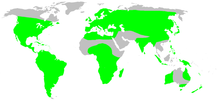Tube-dwelling spider
This article needs additional citations for verification. (November 2015) |
| Tube-dwelling spiders | |
|---|---|

| |
| Segestria florentina | |
| Scientific classification | |
| Domain: | Eukaryota |
| Kingdom: | Animalia |
| Phylum: | Arthropoda |
| Subphylum: | Chelicerata |
| Class: | Arachnida |
| Order: | Araneae |
| Infraorder: | Araneomorphae |
| Family: | Segestriidae Simon, 1893[1] |
| Genera | |
|
See text. | |
| Diversity[2] | |
| 4 genera, 106 species | |

| |
The tube-dwelling spiders (family Segestriidae) consist of two large and widespread genera (Segestria and Ariadna) and two smaller genera, Citharoceps and Gippsicola. The family is easily recognized because its members have six eyes (most spiders have eight) arranged in a semicircle and have the first three pairs of legs arranged forward (most spiders have only the first two pairs so arranged.) The leg structure appears to be an adaptation for living in silken tubes, which unlike those of the atypical tarantulas, may branch and are often built in tree bark fissures, as well as under stones. These are haplogyne primitive araneomorphs related to the Dysderidae, being placed in clade or superfamily Dysderoidea. Both Segestria and Ariadna are known from North America, South America, Eurasia, Africa and New Zealand, while Ariadna is also known from Australia. This wide distribution attests to the ancient origin of this family.
Genera
As of November 2015[update], the World Spider Catalog accepts the following genera:[1]
- Ariadna Audouin, 1826 – America, Africa, Asia, Australia, Europe
- Citharoceps Chamberlin, 1924 – USA, Mexico
- Gippsicola Hogg, 1900 – Australia
- Segestria Latreille, 1804 – Palearctic, Americas, New Zealand, Central Asia
See also
References
- ^ a b "Family: Segestriidae Simon, 1893", World Spider Catalog, Natural History Museum Bern, retrieved 2015-11-10
- ^ "Currently valid spider genera and species", World Spider Catalog, Natural History Museum Bern, retrieved 2015-11-10
